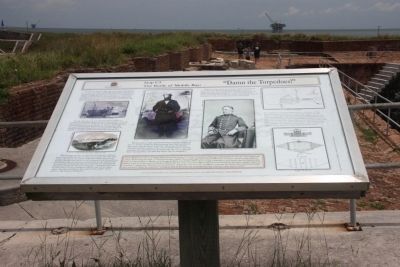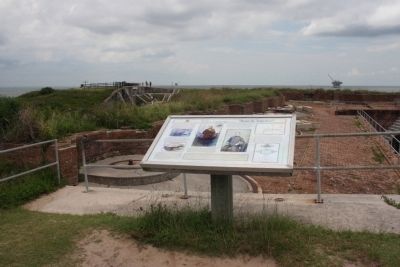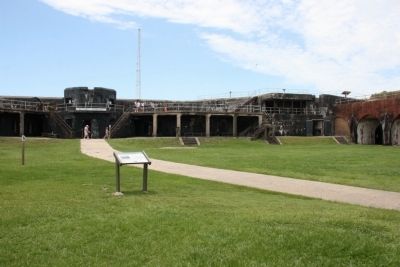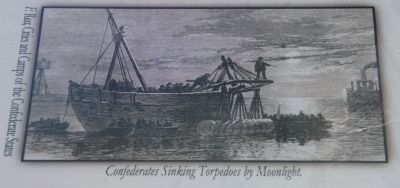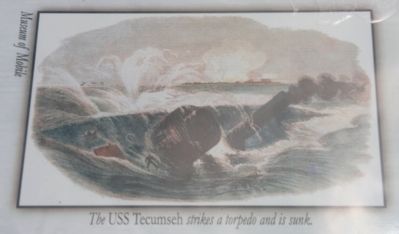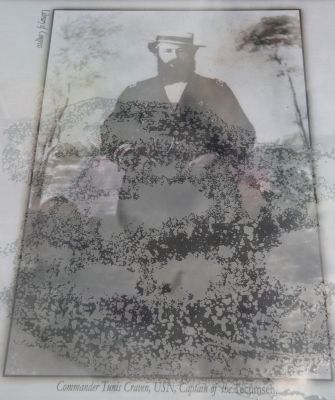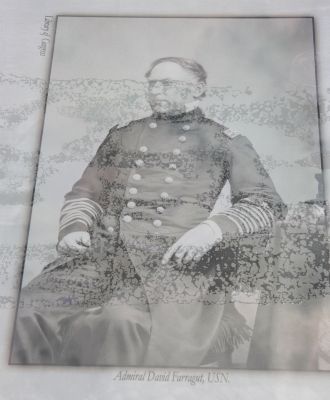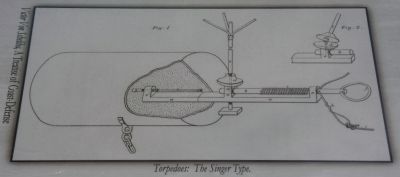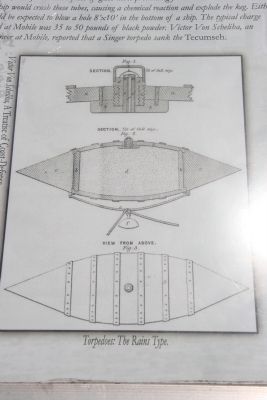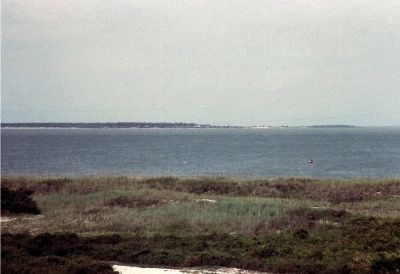Near Gulf Shores in Baldwin County, Alabama — The American South (East South Central)
The Battle of Mobile Bay
“Damn the Torpedoes!”
— Civil War Trail, Battle for Mobile Bay —
At 7:25 a.m., August 5, 1864, Admiral Farragut’s lead monitor Tecumseh steered into the torpedo field at the mouth of Mobile Bay. The admiral had ordered Commander Tunis Craven, the Tecumseh’s captain, to engage the ram Tennessee. Then west of the black buoy marking the eastern limit of the torpedo field, the Tennessee was steaming further west. Craven was too close to the black buoy to steer east of it; if he was to catch the Ram, he would have to move west of the buoy. He did.
At 7:40, 100 yards away from his prey, Craven’s ship hit a torpedo and sank within three minutes. Farragut faced a crisis, too. He could keep his fleet, blocked by the Brooklyn and the torpedoes, under the guns of the fort, withdraw, or advance and plunge into the torpedo field himself. Warned by his subordinates of the torpedoes, Farragut is reported to have exclaimed, “Damn the torpedoes, full speed ahead!” and led his fleet into the Bay.
Did Farragut actually say this? No contemporary authority proves that he did. The din of battle was so great that only those within a few feet of the admiral could have heard what he said. Farragut himself said afterward that he prayed for divine guidance, and his pilot, Martin Freeman, remembered that the admiral said he would take the lead and “told me to pick my way [through the torpedoes] and go into the bay or blow up…” Freeman then used his voice tube to convey Farragut’s orders to the Hartford’s deck officer. The pilot would have then ordered “four bells!” which means to “go ahead at full speed.”
On November 8, 1864, Captain Thornton A. Jenkins, skipper of the USS Richmond, mailed an article from the New York Commercial Advertiser to the Secretary of the Navy. The article read in part: “The pilot told [the captain of the Tecumseh] that he was too near the torpedoes; the captain [Craven] pointed to the ram Tennessee and said ‘damn the torpedoes, I am after that fellow; take me alongside.”
It does not much matter what Farragut said. It is what he did that is important. Both he and Craven were fully aware of the dangerous uncertainties presented by torpedoes, and both he and Craven took their ships through the torpedo field at full speed. Craven lost his ship and his life, but Farragut took decisive action a moment of crisis and saved his fleet from certain defeat.
The Confederates used two types of contact torpedoes in Mobile Bay: the Singer torpedo and the Rains “keg” torpedo. The Singer torpedo made of iron, tin, or copper, had a spring trigger which, when released, caused a plunger to ignite the fuse. The Rains torpedo, made of oak barrels lined with pitch and coated with tar on the outside, had five or more fuses of glass tubes protruding from the barrel. Contact with a ship would crush those tubes, causing a chemical reaction and explode the keg. Either could be expected to blow a hole 8’x10’ in the bottom of a ship. The typical charge used at Mobile was 35 to 50 pounds of black powder. Victor Von Scheliha, an engineer at Mobile, reported that a Singer torpedo sank the Tecumseh.
Inset On Bottom:
Thom Williamson, who, as a young officer, served aboard the USS Hartford, remembered Farragut ordering him to “Go on!” The young man asked, “Shall I ring four bells…?” Excited, Farragut replied, “Four bells-eight bells-sixteen bells-damn it, I don’t care how many bells you ring!” Lieutenant John C. Kinney, an army signal officer, was another officer close enough to Farragut to have heard what the Admiral said. Kinney wrote an article about the Battle of Mobile Bay for Scribner’s Monthly in 1881 in which he never mentioned Farragut’s alleged “damn the torpedoes!” exclamation. However, in a second essay, written for Battles and Leaders in 1884, he wrote that the current story held that Farragut had exclaimed “damn the torpedoes!” during the heat of the battle
and concluded that this “may have some basis in truth.”
Erected by Mobile Bay Convention and Visitors Bureau. (Marker Number Stop C3.)
Topics. This historical marker is listed in this topic list: War, US Civil. A significant historical month for this entry is November 1788.
Location. 30° 13.69′ N, 88° 1.403′ W. Marker is near Gulf Shores, Alabama, in Baldwin County. Marker can be reached from Fort Morgan Road (Alabama Route 180) 1.7 miles west of Dune Drive when traveling west. Located in Fort Morgan State Historic Park. Touch for map. Marker is at or near this postal address: 51 Highway 180 West, Gulf Shores AL 36542, United States of America. Touch for directions.
Other nearby markers. At least 8 other markers are within walking distance of this marker. A different marker also named The Battle of Mobile Bay (here, next to this marker); Panama Mount (a few steps from this marker); a different marker also named The Battle of Mobile Bay (a few steps from this marker); Citadel (1825-1865) (within shouting distance of this marker); The Citadel (within shouting distance of this marker); The Battery Bailey (about 300 feet away, measured in a direct line); Battery Thomas (1898-1917) (about 300 feet away); 6.4” (100 pounder) Parrott Rifle / 7” Brooke Rifle (about 400 feet away). Touch for a list and map of all markers in Gulf Shores.
More about this marker. This marker
is within the walls of historic Fort Morgan. The marker is located on the top level, west side of Battery Duportail.
Also see . . . Civil War Trail, Battle For Mobile Bay. (Submitted on October 16, 2013, by Timothy Carr of Birmingham, Alabama.)
Credits. This page was last revised on July 25, 2018. It was originally submitted on October 16, 2013, by Timothy Carr of Birmingham, Alabama. This page has been viewed 2,655 times since then and 86 times this year. Photos: 1, 2, 3, 4, 5, 6, 7, 8, 9, 10. submitted on October 16, 2013, by Timothy Carr of Birmingham, Alabama. • Bernard Fisher was the editor who published this page.
